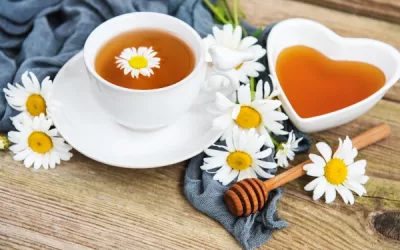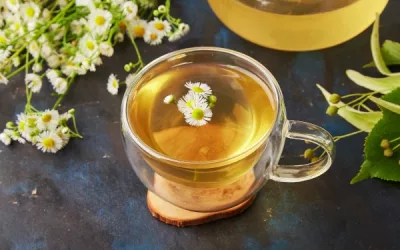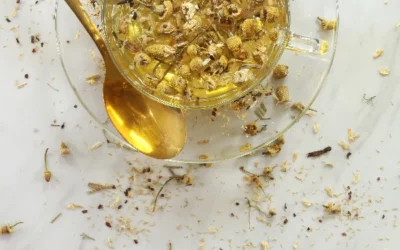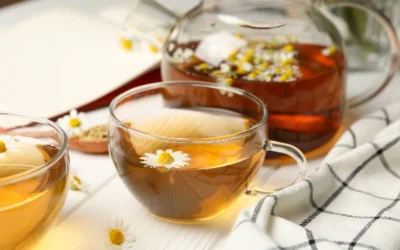Have you ever sipped on a warm cup of chamomile tea, wondering if it might keep you awake at night? As tea enthusiasts and health-conscious individuals seek natural remedies, understanding chamomile’s caffeine content is crucial. The truth is, chamomile tea is naturally caffeine-free, making it an excellent choice for relaxation and wellness. This article dives into chamomile tea’s benefits, its effects on sleep and digestion, antioxidant properties, potential side effects, and how it stacks up against other herbal teas. Let’s uncover the fascinating truths behind this beloved brew!
Table of Content
Is chamomile tea caffeine-free?
Chamomile tea is a beloved herbal beverage known for its soothing properties and gentle flavour. One of its key characteristics is that it is naturally caffeine-free. Unlike traditional teas—such as black, green, and oolong—chamomile is made from the flowers of the chamomile plant, which do not contain caffeine. This makes it an excellent choice for those sensitive to caffeine or looking to avoid it for health reasons.
Herbal teas, in general, are typically caffeine-free, setting them apart from traditional teas derived from the Camellia sinensis plant. Consuming chamomile tea can provide a calming experience without the jittery effects of caffeine.
This natural remedy is often recommended for its calming effects, which can help improve sleep and reduce anxiety.
What makes chamomile tea a suitable choice for those avoiding caffeine?
Chamomile tea stands out as an ideal option for those steering clear of caffeine for several reasons:
- Natural caffeine-free composition
- Gentle on the stomach
- Known for its relaxing properties
- Can be consumed at any time of day without disrupting sleep
- Supports overall well-being with its anti-inflammatory and antioxidant benefits
Given these attributes, chamomile tea not only avoids the stimulating effects of caffeine but also offers additional health benefits, making it a worthy alternative to caffeinated beverages.
How does chamomile tea compare to other herbal teas regarding caffeine?
When comparing chamomile tea to other herbal teas, it is essential to note that most herbal teas are naturally caffeine-free. This includes favourites like peppermint, rooibos, and hibiscus tea.
- Peppermint tea: Refreshing and caffeine-free, known for aiding digestion.
- Rooibos tea: Also caffeine-free, with rich antioxidants and a unique flavour.
- Hibiscus tea: No caffeine and contains high levels of Vitamin C and minerals.
- Ginger tea: Spicy and caffeine-free, it helps with nausea and digestion.
- Lemon balm tea: Calming and caffeine-free, often used for its relaxing effects.
Chamomile tea holds its own among these herbal options by offering a gentle, floral taste and potent calming effects, making it a staple in the world of caffeine-free beverages.
Can chamomile tea be consumed at any time of the day?
Yes, you can enjoy chamomile tea at any point throughout your day. Its lack of caffeine means it won’t interfere with your sleep patterns, making it perfect for a bedtime ritual.
- Enjoy it in the morning for a calm start
- Sip it post-lunch to avoid the afternoon slump
- Have a cup in the evening to wind down
- Drink it before bed to support better sleep
- Use it during stressful moments for relaxation
Chamomile tea’s versatility and soothing nature make it an exceptional choice for any time. Its calming effects are beneficial in various situations, whether starting your day with tranquility or ending it on a serene note.
In ancient Egypt, chamomile was revered for its medicinal properties. The Egyptians used chamomile to treat ailments and dedicated the flower to the sun god Ra due to its healing abilities.
This historical appreciation underscores the longstanding value of chamomile as a healing herb, a legacy that continues today.
From my own experience, I started drinking chamomile tea during a particularly stressful period in my life. I found that winding down with a cup of chamomile tea in the evening helped ease my anxiety and improved my sleep quality.
Now, it’s a daily ritual I wouldn’t part with.
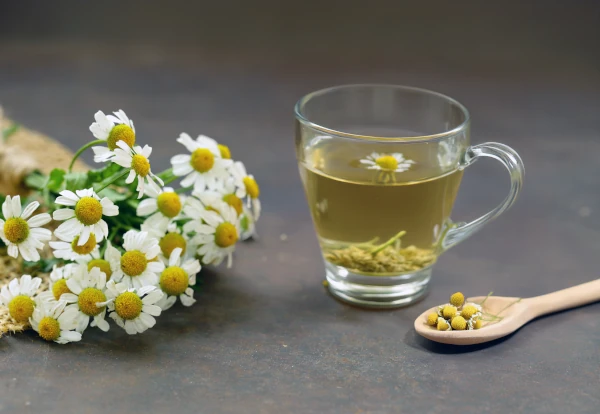
How to prepare and enjoy chamomile tea?
Chamomile tea, much like those perfect lazy Sunday mornings, has a way of making you feel super relaxed. But prepping it isn’t just about dunking a teabag in hot water. There’s an art to it.
Chamomile tea is pretty versatile. There’s German chamomile, which is milder and more commonly used for tea, and Roman chamomile, which has a slightly more bitter and robust flavour. Whichever you prefer, let’s dive into the nitty-gritty of making a cup that’ll make you go, “Ah, this is the life!”
What are the best practices for brewing chamomile tea?
There’s a method to this relaxation madness, and it starts with understanding how to brew chamomile tea correctly.
Here’s how to get it just right:
- Start with fresh water: Always use cold, fresh water. Stale water equals stale tea. Simple.
- Measure out your chamomile: If you’re using loose dried flowers, about a tablespoon per cup does the trick.
- Temperature: Boil your water, but let it cool for a minute before pouring it over the chamomile. Too much heat can make it taste like burnt daisies.
- Steep time: Let it steep for 5-10 minutes. Any longer, and you’ll be sipping on something that tastes like an old lawn.
- Strain and serve: If you used loose flowers, use a fine-mesh strainer. No one likes a surprise flower petal in their sip.
So, get your teapot out, because it’s tea time.
Can chamomile tea be used in recipes, and if so, how?
Oh, you bet your bottom dollar chamomile tea can be more than just your beverage-buddy. It’s pretty versatile in the kitchen too.
Check out these culinary marvels:
- Chamomile tea-infused cakes: Replace water or milk in your cake recipe with chamomile tea for a subtle floral note.
- Chamomile sorbet: Yep, you read right. Steep chamomile in hot water, mix with sugar, lemon juice, and freeze. Voila, a cool treat.
- Chamomile simple syrup: Infuse chamomile in your syrup for cocktails or mocktails.
- Savory Chamomile Chicken: Marinate chicken in chamomile tea, olive oil, and spices for a unique twist.
- Chamomile rice: Cook rice in chamomile tea instead of water for a delicate floral flavour.
These ideas can make even Gordon Ramsay nod approvingly.
What are some popular flavour combinations with chamomile tea?
You can drink your chamomile tea straight up, but where’s the fun in that? Try jazzing it up with different flavours for a cup that’s anything but boring.
Here’s what you can mix it with:
- Honey: A classic partner. Adds sweetness and soothes your throat.
- Lemon: Brightens up the floral notes with a citrusy zing.
- Mint: Keep it cool and refreshing.
- Lavender: Double down on the calming vibes.
- Cinnamon: Adds a warm, spicy kick, perfect for cold days.
- Ginger: Zesty and perfect if you’re feeling under the weather.
Give these combinations a go and find your perfect chamomile blend.
Back in the 19th century, chamomile tea wasn’t just a trendy herbal remedy, it had its roots (pun totally intended) in various cultures. It was a popular drink across Europe, and the Egyptians even dedicated it to their gods.
Ancient Greek physician Hippocrates recommended it as a treatment for fevers. But in World War II, British soldiers would brew chamomile flowers not for relaxation but to clean and heal wounds in makeshift hospitals! This little flower sure has a rich history, doesn’t it?
So next time you sip on your chamomile tea, remember, you’re part of a long tradition of folks who knew a good thing when they tasted it.
How does chamomile tea compare to other herbal teas?
Chamomile tea, often hailed as the go-to beverage for relaxation, isn’t just another herbal tea on the block. Sure, it sits comfortably alongside peppermint, rooibos, and hibiscus in your herbal tea collection, but it has its own unique attributes and a slightly pompous attitude about them.
It’s time to spill the tea, quite literally, on how chamomile stands out among its herbal siblings.
First off, let’s chat about chamomile’s caffeine kick—or lack thereof. Unlike black, green, or even some white teas that will have you bouncing off the walls, chamomile tea is caffeine-free.
This virtue makes it an excellent evening companion, like that friend who knows how to keep you calm and doesn’t insist on partying all night. It’s a natural sedative, promoting relaxation and sleep.
Beyond its caffeine-free persona, chamomile tea boasts a range of health benefits that genuinely put it in a class of its own. It’s like the overachiever in school – remember that one?
Packed with antioxidants, it’s touted for easing digestive issues, reducing inflammation, and even offering some headache relief. Not to mention, it’s a common home remedy for an array of minor ailments.
The taste of chamomile? Imagine a light, floral note that dances on your taste buds, coupled with a gentle sweetness that’s borderline addictive. Peppermint tea, by contrast, is like a menthol tornado – it’s refreshing and intense, perfect for those days when you need a pick-me-up sans caffeine. Chamomile, however, wants you to mellow out and find your zen.
Culturally, chamomile tea wears a royal crown. In ancient Egypt, it was associated with the gods and used ceremonially. Meanwhile, other herbal teas like peppermint have been more kitchen staples than cultural icons. Chamomile’s reputation as a medicinal marvel has spanned various cultures for centuries, making it not just a tea, but a tradition.
How does the caffeine content of chamomile tea compare to peppermint tea?
Chamomile and peppermint are herbal teas partying in the caffeine-free zone. Both of these herbal teas flaunt their lack of caffeine like they’re competing for first place in a sleep competition.
- Caffeine-Free Club: Neither chamomile nor peppermint contains caffeine, making them perfect for evening or nighttime sipping.
- Sleep Support: Chamomile is famous for being a sleep enhancer, while peppermint, although calming, doesn’t have the same soporific reputation.
- Health Benefits: Both are champions for digestion. Chamomile soothes your stomach, and peppermint can ease bloating and cramps.
- Taste Profiles: Chamomile is subtly sweet and floral, whereas peppermint brings a brisk, cooling sensation.
- Antioxidant Powers: Both are loaded with antioxidants, but chamomile’s specific ones have anti-inflammatory and potential anti-cancer properties.
So, if you’re wondering which is better for unwinding before bed without the unwelcome jittery caffeine vibes, you can’t go wrong with either. But if it’s pure tranquillity you seek, chamomile wears the crown.
What unique benefits does chamomile tea offer compared to other herbal teas?
Chamomile tea isn’t just resting on its laurels; it’s actually quite the overachiever when it comes to health perks, positioning itself as the guardian of your well-being.
- Sedative Properties: Chamomile is your go-to for relaxation and better sleep, thanks to its mild sedative effects.
- Digestive Aid: It can relieve issues like indigestion, bloating, and even tummy aches, working as a muscle relaxant on the digestive tract.
- Anti-Inflammatory Agent: Its antioxidants fight off inflammation and promote healing.
- Skin Soother: Used topically, it can reduce skin irritations and promote healing, making it a natural choice for minor cuts and burns.
- Mental Health Ally: Chamomile has been known to reduce symptoms of anxiety and depression, working as a gentle mood enhancer.
In comparison, other herbal teas have their own merits but usually focus on single-issue remedies. Chamomile is like a Swiss army knife—ready to tackle multiple ailments with finesse.
How do cultural perceptions of chamomile tea differ from other herbal teas?
In the grand tapestry of tea culture, chamomile tea commands a special place, often seen as the quintessential calming drink across various cultures.
- Ancient Egypt: Associated with the sun god Ra and revered for medicinal and ceremonial uses.
- Roman Empire: Used for its fragrance in incense and as a natural remedy, which shows the broad scope of its appreciation.
- Traditional Medicine: In Europe and North America, it’s been a staple in folk medicine for centuries, prescribed for everything from insomnia to digestive issues.
- Modern-Day Spa: Today, it’s synonymous with tranquillity and relaxation, often found in wellness centres and spas.
Contrast that with, say, peppermint tea, which doesn’t quite have the same historical gravitas. Peppermint’s more of a culinary and medicinal staple without the ceremonial flair. Chamomile is like the wise old sage, while peppermint is the trusty sidekick.
To cap things off, let’s take a stroll down memory lane to ancient Egypt, where we find that chamomile was so highly regarded, it was offered to the gods. It was particularly associated with Ra, the sun god, symbolising its importance.
Healers would use chamomile as a herbal potion to fight fevers and promote health. It wasn’t just a beverage but a revered element of spiritual and physical healing practices. Imagine sipping on chamomile tea knowing that you’re partaking in a ritual that once appeased the gods.
Now, doesn’t that make you feel just a bit grander with each sip?
What are the health benefits of chamomile tea?
Chamomile tea, known for its soothing qualities, has been used for centuries to treat various ailments. This herbal tea is made from the dried flowers of the chamomile plant and is cherished for its calming properties. But, its benefits go far beyond just relaxation.
To help you understand the numerous advantages of chamomile tea, I’ve created a table that breaks down its health benefits, supporting research, and potential side effects. This table will help you make an informed decision about incorporating chamomile tea into your routine.
Health benefits of chamomile tea
The table below summarises the health benefits of chamomile tea, the evidence supporting these benefits, and any potential side effects. This format will allow you to easily see how chamomile tea can aid in various health aspects, while also noting any precautions you should take.
| Benefit | Evidence | Side Effects |
|---|---|---|
| Sleep Aid | Studies show chamomile can improve sleep quality and help with insomnia. | May cause allergic reactions |
| Digestive Health | Chamomile can soothe the stomach and aid in digestion. | Possible mild nausea |
| Anti-Inflammatory | Contains compounds that reduce inflammation. | Rare skin reactions |
| Anxiety Relief | Research indicates chamomile can reduce anxiety symptoms. | Drowsiness in some cases |
| Immune Support | Has antibacterial properties that boost the immune system. | Potential interactions with blood thinners |
| Skin Health | Helps in treating skin conditions like eczema. | Skin irritation for some |
| Menstrual Pain Relief | Can alleviate menstrual cramps and discomfort. | No significant side effects noted |
How to use and understand the table
- Benefit: Lists the positive effects of drinking chamomile tea.
- Evidence: Provides a summary of research findings supporting each benefit.
- Side Effects: Outlines any potential negative reactions or precautions to consider.
Now that you have a clear understanding of the benefits and potential side effects of chamomile tea, let’s dive deeper into how you can add this soothing beverage to your daily routine.
How to incorporate chamomile tea into your daily routine
Chamomile tea can be a versatile addition to your daily habits, whether you’re looking to unwind after a long day or seeking natural remedies for minor ailments.
- Drink before bed: A warm cup of chamomile tea can help you relax and prepare for a good night’s sleep.
- After meals: Sip chamomile tea after meals to aid digestion and reduce bloating.
- Daily relaxation: Include it in your daily routine to manage stress and anxiety.
- Skin care: Use chamomile tea as a natural skin toner to soothe irritation and inflammation.
- Cold remedy: Drink chamomile tea when you have a cold to boost your immune system.
Chamomile tea can be enjoyed hot or cold, and you can add honey or lemon for extra flavour and benefits.
Potential interactions with medications and how to stay safe
It’s essential to be mindful of any potential interactions chamomile tea might have with medications you are taking.
- Consult your doctor: If you’re on medication, especially blood thinners, consult your healthcare provider before drinking chamomile tea.
- Monitor for allergies: If you have a known allergy to plants in the daisy family, be cautious, as chamomile can cause allergic reactions.
- Start small: Begin with a small amount of chamomile tea to see how your body reacts before making it a regular part of your routine.
- Pregnancy and nursing: Pregnant or nursing women should consult a doctor before consuming chamomile tea, as its safety in these conditions is not fully established.
In ancient Egypt, chamomile was often used as a remedy for fever and other ailments. The Egyptians even dedicated the flower to their gods due to its healing properties.
The Greeks and Romans also recognised its medicinal benefits, using it to treat various conditions ranging from gastrointestinal problems to inflammation. This long history of use speaks volumes about the enduring trust in chamomile’s therapeutic potential.
When I first started drinking chamomile tea, I was sceptical about its calming effects. But after a stressful day, sipping on a cup genuinely helped me unwind. It has now become a nightly ritual. I love adding a dash of honey to mine for a touch of sweetness.
Give it a try—you might find it becomes your go-to beverage for relaxation too!
What are the antioxidant properties of chamomile tea?
Chamomile tea is a bit of a hero in a cup. Why? Because it’s absolutely packed with antioxidants! Sip on this golden brew, and you’re essentially guzzling down a whole army of health-boosting compounds known as flavonoids, especially apigenin.
These are like the superheroes of the tea world, armed and ready to combat free radicals and overall body nastiness.
Apigenin and other flavonoids in chamomile are famous for their anti-inflammatory, antiviral, and antibacterial properties. Not just bragging rights but real stuff that translates into actual health benefits.
And let’s not forget, compared to other herbal teas, chamomile stands proud with its exceptional soothing characteristics that not only help you catch some Zs but also pack a powerful antioxidant punch.
How do antioxidants in chamomile tea contribute to health?
Antioxidants in chamomile tea are like a personal security detail for your cells. They chase away those troublesome free radicals causing havoc in your body. Apigenin, a key flavonoid found in chamomile, works wonders.
- Reduces inflammation: Cuts down on that nagging redness and swelling.
- Boosts the immune system: A stronger defence against the common cold and other nuisances.
- Fights bacteria and viruses: Helps keep infections at bay.
- Protects against chronic diseases: Lowers the risk of conditions like heart disease and diabetes.
- Enhances skin health: Bye-bye acne, hello radiant skin.
These compounds offer a protective shield, safeguarding your body’s cells and boosting your overall health and wellbeing. It’s like having a health insurance policy in every sip.
How does chamomile tea compare to green tea in terms of antioxidants?
Ah, the age-old rivalry: chamomile vs green tea. Both have their own fan clubs, and rightly so. Here’s how they stack up:
- Chamomile: Packed with apigenin, luteolin, and quercetin.
- Green tea: Rich in catechins and epigallocatechin gallate (EGCG).
- Soothing effects: Chamomile wins, hands down.
- Antioxidant power: Green tea has more general antioxidants, but chamomile offers unique anti-inflammatory benefits.
- Flavour: Chamomile’s mild, floral notes vs green tea’s slightly bitter, vegetal flavour.
In the antioxidant face-off, green tea might have the upper hand in sheer quantity, but chamomile brings unique qualities to the table with its exceptional healing properties.
What are the long-term benefits of regular chamomile tea consumption?
Regularly drinking chamomile tea isn’t just about those cosy evenings; it’s a gift that keeps on giving. Let’s unwrap that:
- Improved sleep quality: Regular chamomile helps you drift to dreamland faster.
- Better digestion: Less bloating, gas, and the like.
- Reduced anxiety: It’s like a mini-meditation session in a mug.
- Enhanced immune function: Fewer sick days, more fun days.
- Anti-ageing effects: Thanks to those antioxidants fighting wrinkles and fine lines.
The long-term benefits go beyond just a temporary feel-good factor. You’re setting yourself up for a healthier, more vibrant future with each cup.
Believe it or not, ancient history has its own tea tales. Take the Romans, for instance—they cherished chamomile for its healing properties. Not only did they use it for tea, but they also relied on chamomile as a medicinal herb.
The Greek physician Dioscorides prescribed it for digestive disorders, easing headaches, and even calming down those gladiators with a bout of anxiety. So next time, as you sip your chamomile tea, remember you’re partaking in a tradition that’s been celebrated for centuries.
And hey, if it was good enough for the gladiators, it’s probably worth a shot for us too!
Are there any side effects of drinking chamomile tea?
Picture this: you’ve had a long, exhausting day, and all you want is to sink into your comfiest chair with a warm cup of chamomile tea. But then you start wondering, “Are there any side effects of drinking chamomile tea?” Well, my friend, let’s dive into the nitty-gritty, because even your favourite herbal relaxant isn’t all sunshine and daisies.
Chamomile tea, a true herbal superstar, can sometimes come with a few unwelcome surprises. While it’s generally considered safe (I mean, even grandmas swear by it), there are certain side effects to be mindful of.
Enter the key issues: allergic reactions, interactions with medications, and specific populations who should probably keep their distance.
Who should avoid drinking chamomile tea?
Let’s get straight to it: not everyone should be guzzling down chamomile like it’s water.
- Pregnant women: Drinking chamomile tea might trigger uterine contractions, which is NOT what you want when expecting.
- Allergy-prone individuals: If you’re allergic to plants in the daisy family like ragweed, marigolds, or chrysanthemums, steer clear.
- People on blood thinners: Chamomile contains natural blood-thinning compounds, so it could potentiate the effect of anticoagulant medications.
- Infants and young children: Their sensitive systems might not appreciate the herbal overload, potentially leading to allergies or tummy issues.
So, if you fall into one of these categories, it’s best to play it safe and avoid chamomile tea.
What are the signs of an allergic reaction to chamomile?
Alright, now let’s talk allergies. Immune systems can sometimes go haywire, even with innocent-looking chamomile flowers.
- Skin reactions: Redness, hives, itching or any bizarre skin conditions popping up out of nowhere.
- Respiratory issues: Wheezing, shortness of breath, or a tightening sensation in the chest.
- Digestive problems: Nausea, vomiting, or tummy cramps that feel like you’ve swallowed a gremlin.
- Severe reactions: In rare cases, anaphylaxis—a life-threatening reaction that calls for immediate medical attention.
If any of these signs show up after sipping that chamomile tea, it’s time to put the kettle away and call a doc ASAP.
How can one safely incorporate chamomile tea into their diet?
So, you’ve navigated the minefield of allergies and potential risks, and you’re ready to enjoy your chamomile fix without any drama. Here’s how to do it right:
- Start small: Sip on a small amount initially to see how your body reacts. Don’t go all-in from the get-go.
- Consult your doctor: Especially if you’re on medications like anticoagulants or have other health concerns.
- Choose quality: Stick to reputable brands to avoid contamination and ensure you’re getting pure chamomile.
- Moderation is key: One or two cups a day should be plenty. This isn’t a chugging contest.
- Monitor yourself: Be aware of any new, unusual symptoms and take note of how you feel after drinking the tea.
By taking these steps, you’ll be treating yourself to the calming benefits of chamomile tea while avoiding any unwanted side effects.
Way back in ancient Egypt, chamomile was cherished as a cure-all remedy. Cleopatra herself is rumoured to have used chamomile-infused baths to maintain her legendary beauty. But here’s the kicker—ancient healers cautioned that, like all good things, it should be used wisely and in moderation. So, as with Cleopatra’s beauty routine, a little chamomile goes a long way. Drink smart, stay healthy!
Conclusion
In wrapping up our exploration of chamomile tea, it’s clear that this humble herbal infusion is much more than a caffeine-free beverage. By delving into its unique properties, we’ve discovered that chamomile tea not only offers a serene alternative for those sensitive to caffeine, but it also boasts a wealth of health benefits ranging from improved sleep quality to enhanced digestion. The calming effects attributed to its compound, apigenin, highlight its potential as a natural aid for achieving a restful night’s sleep, while its anti-inflammatory properties contribute to digestive well-being.
Moreover, the antioxidant qualities of chamomile tea set it apart in the realm of herbal teas, with implications that could bolster overall health through regular consumption. While it’s noteworthy that some individuals may experience side effects or allergic reactions, careful consideration and moderate use can allow many to enjoy its soothing embrace.
As we reflect on the growing interest in natural remedies, chamomile tea serves as an exemplary model of how nature provides solutions to common health concerns. For those seeking to incorporate it into their lives, I encourage you to experiment with various brewing methods and flavour enhancements, making your tea-drinking experience both enjoyable and beneficial.
In the words of Ralph Waldo Emerson, “The creation of a thousand forests is in one acorn.” So too, the satisfying ritual of sipping chamomile tea can cultivate a garden of well-being in our lives. As you contemplate your health journey, consider the impact of small yet significant choices—like enjoying a cup of chamomile tea—that can lead to profound benefits.
Resources
- A narrative review on the potential therapeutic benefits of chamomile
- The Effect of Oral Chamomile on Anxiety: A Systematic Review of Clinical Trials
- The Antioxidant and Anti-inflammatory Properties of Chamomile and Its Constituents
- Investigation of antioxidant properties of chamomile consumed as herbal tea
- A Comprehensive Study of Therapeutic Applications of Chamomile
- Chamomile: A herbal medicine of the past with bright future
- Apigenin: a natural molecule at the intersection of sleep and aging
- Apigenin: a natural molecule at the intersection of sleep and … – PubMed
- Therapeutical properties of apigenin: a review on the experimental …


